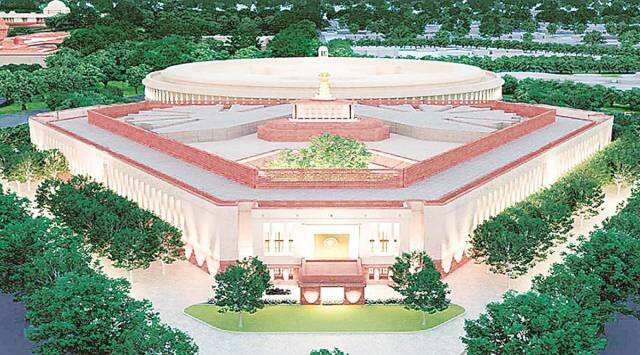New Parliament
New Parliament

Why in news? Prime Minister Narendra Modi inaugurated the new Parliament building at a grand ceremony that included a havan, multi-faith prayers and the installation of the Sengol in a special enclosure in the Lok Sabha chamber.
Highlights:
- The new Parliament building marks the dawn of a self-reliant and developed India, which will also inspire the progress of other nations.
- Prime Minister called it a symbol of the “aspirations” of 140 crore citizens and a vehicle that will drive India in the next 25 years towards its goal of becoming a “developed country” to coincide with the 100th anniversary of the nation’s .
- Designed by Ahmedabad-based HCP Design, Planning and Management under architect Bimal Patel, the structure has been built adjacent to the existing Parliament House by Tata Projects Limited.
Why does India need a new Parliament building?
The existing Parliament House, which was commissioned in 1927, is almost a century old Heritage Grade-I building that has seen a massive increase in parliamentary activities and users over the decades.
Some of the major issues, according to the official central vista project website are:
- Narrow seating space for MPs: The present building was never designed to accommodate a bicameral legislature for a full-fledged democracy. The number of Lok Sabha seats is likely to increase significantly from the current 545 after 2026, when the freeze on the total number of seats lifts.
The Central Hall has seating capacity only for 440 persons. When the Joint Sessions are held, the problem of limited seats amplifies. Due to limited space for movement, it is also a huge security risk.
- Distressed infrastructure: The addition of services like water supply and sewer lines, air conditioning, fire fighting equipment, CCTV cameras, etc., have led to seepage of water at several places and impacted the aesthetics of the building. Fire safety is a major concern at the building.
- Obsolete communication structures: Communications infrastructure and technology is antiquated in the existing Parliament, and the acoustics of all the halls need improvement.
- Safety concerns: The current Parliament building was built when Delhi was in Seismic Zone-II; currently it is in Seismic Zone-IV. This raises structural safety concerns.
- Inadequate workspace for employees: Over the years, inner service corridors were converted into offices which resulted in poor-quality workspaces. In many cases, these workspaces were made even smaller by creating sub-partitions to accommodate more workers.
The main features of the new Parliament building
- It has a built-up area of about 65,000 sq m, with its triangular shape ensuring the optimum utilisation of space.
- The new building will house a larger Lok Sabha hall with a capacity of up to 888 seats, and a larger Rajya Sabha hall with a capacity of upto 384 seats. The Lok Sabha may accommodate up to 1,272 seats for joint sessions of Parliament.
- The Lok Sabha hall is based on the peacock theme, India’s national bird.
- The Rajya Sabha is based on the lotus theme, India’s national flower.
- A state of the art Constitutional Hall in the building symbolically and physically puts the Indian citizens at the heart of our democracy.
- The building will have ultra-modern office spaces that will be secure, efficient, and equipped with the latest communications technology.
- The new building will have large committee rooms with the latest audio-visual equipment, and will provide a superior library
- A “Platinum-rated Green Building”, the new Sansad Bhavan will embody India’s commitment towards environmental sustainability.
- The building will be an embodiment of Indian heritage, reflecting the “vibrance and diversity of modern India, incorporating our cultural and regional arts and crafts.
- The new Parliament will be divyang friendly, and people with disabilities will be able to move around freely.
- A Central Lounge that will complement the open courtyard will be a place for members to interact with each other. The courtyard will have a banyan, the national tree.
In conclusion, the new Parliament building in India represents a remarkable fusion of modern and traditional architectural styles. It not only provides enhanced functionality but also holds the potential to shape the country’s political landscape by inspiring democratic values and fostering collaboration. With its inclusive design and sustainable features, the structure sets a benchmark for future developments.
A special commemorative postage stamp and a Rs 75 coin
- Prime Minister Narendra Modi released a special commemorative postage stamp and a Rs 75 coin to mark the inauguration of the new Parliament building.
- The weight of the coin would be 34.65-35.35 grams.
- One side of the coin will bear the image of the Lion Capital of the Ashoka Pillar in the centre, flanked by the word “Bharat” in Devanagari script and “INDIA” in English.
- The rupee symbol and denominational value “75” in international numerals will also be inscribed below the Lion Capital.
- The other side of the coin will bear the image of the Parliament Complex and the year “2023” in international numerals below the image.

